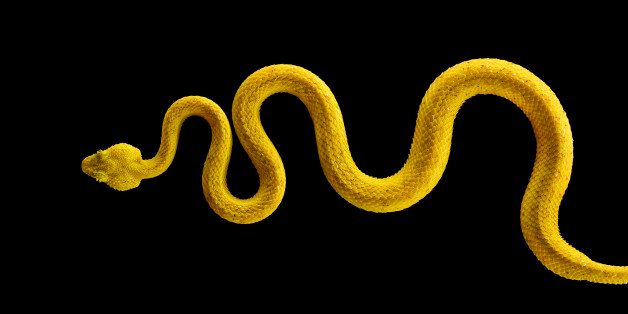
The sinuous shape triggers a primal jolt of recognition: snake! A new study of the monkey brain suggests that primates are uniquely adapted to recognize the features of this slithering threat and react in a flash. The results lend support to a controversial hypothesis: that primates as we know them would never have evolved without snakes.
A tussle with a snake meant almost certain death for our preprimate ancestors. The reptiles slithered through the forests of the supercontinent Gondwana roughly 100 million years ago, squeezing the life out of the tiny rodent-sized mammalian ancestors of modern primates. About 40 million years later, likely after primates had emerged, some snakes began injecting poison, which made them an even deadlier and more immediate threat.
Snakes were “the first and most persistent predators” of early mammals, says Lynne Isbell, a behavioral ecologist the University of California, Davis. They were such a critical threat, she has long argued, that they shaped the emergence and evolution of primates. By selecting for traits that helped animals avoid them, snakes ultimately endowed us with forward-facing eyes, for example, and enlarged visual centers deep in our brains that are specialized for picking out specific features in the world around us, such as the general shape of a snake’s body camouflaged among leaves.
Isbell published her “Snake Detection Theory” in 2006. To support it, she showed that the rare primates that have not encountered venomous snakes in the course of their evolution, such as lemurs in Madagascar, have poorer vision than those that evolved alongside snakes.
“It is a very bold theory,” says Arne Öhman, a psychologist at the Karolinska Institute in Sweden who uses brain imaging and behavior studies to test how humans respond to visual threats. But thus far, he says, there has been little neurobiological evidence for it.
Two years ago, neuroscientists at the University of Toyama in Japan and the University of Brasilia in Brazil contacted Isbell, hoping to join her in a search for brain-based evidence. In a paper published online today in the Proceedings of the National Academy of Sciences, the team describes how images of snakes affect the pulvinar—a cluster of neurons in an evolutionarily ancient part of the brain called the thalamus. Pulvinar neurons are believed to help direct our attention using our eyes and recognize a potential threat. Primates have much larger pulvinars than other animals and certain parts of the pulvinar are even unique to primates.
According to Isbell’s hypothesis, other mammals that had to contend with snakes were mostly burrowing creatures, and they didn’t rely as heavily on vision as early primates, which rested in trees during the day. While some mammals developed resistance to snake venoms, primates opted for a better detection strategy.
To test the snake recognition prowess of the pulvinar, the group inserted electrodes into the brains of two captive-born macaque monkeys who had never encountered the reptiles. They measured the electrical spikes from individual neurons in two regions of the pulvinar while the primates looked at four types of images: snakes both coiled and elongated, macaque faces with both angry and neutral expressions, macaque hands in various positions, and geometric shapes such as circles and stars.
They found that images of snakes had a particularly strong and fast-acting effect on pulvinar neurons: Of the 91 neurons that became active at some point in the experiment, 40% were “snake-best,” meaning they were more active during snake photos than other images. These neurons also fired more frequently than the ones responding to faces, hands, or shapes. (Neurons responding to angry faces, an important social threat for the highly social macaques, came in second.) Finally, snake-responsive neurons sprang into action more quickly, activating about 15 milliseconds faster than those that responded to angry faces and about 25 milliseconds ahead of the neutral shape-detecting neurons.
Isbell calls these findings “the first neuroscientific support” for her snake-centric evolutionary theory. She suspects that our unique pulvinar makes primates most adept among mammals at recognizing snakes, though she acknowledges that prediction still needs testing. There is some evidence that primates are especially skilled at detecting snakes that aren’t moving, she says, and that ability may underlie another primate-specific skill: using vision to guide reaching and grasping movements. (Example: Reach for a banana, but don’t reach toward a slumbering snake.)
The results support the idea that primates have built-in mechanisms for recognizing a very specific threat based on its shape, says Isabelle Blanchette, a cognitive psychologist at the University of Quebec, Trois-Rivières, in Canada who studies the role of emotion in how we process information. But she warns that we should resist the urge to extrapolate to humans. Even if we carry these “leftovers from evolution” in the form of snake-sensitive neurons deep in our visual system, higher brain processes, such as learning and memory, may influence our behavior just as much as this deep and instinctive snake sense. “It’s a very important part of the picture, but it is only a part,” she says. Her research has shown that humans aren’t always faster at detecting snakes than other threats, including guns and cars, which we haven’t evolved to fear innately.
ScienceNOW, the daily online news service of the journal Science
